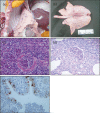Outbreak of swine influenza in Argentina reveals a non-contemporary human H3N2 virus highly transmissible among pigs
- PMID: 21849519
- PMCID: PMC3352566
- DOI: 10.1099/vir.0.036590-0
Outbreak of swine influenza in Argentina reveals a non-contemporary human H3N2 virus highly transmissible among pigs
Abstract
Sporadic outbreaks of human H3N2 influenza A virus (IAV) infections in swine populations have been reported in Asia, Europe and North America since 1970. In South America, serological surveys in pigs indicate that IAVs of the H3 and H1 subtypes are currently in circulation; however, neither virus isolation nor characterization has been reported. In November 2008, an outbreak of respiratory disease in pigs consistent with swine influenza virus (SIV) infection was detected in Argentina. The current study describes the clinical epidemiology, pathology, and molecular and biological characteristics of the virus. Phylogenetic analysis revealed that the virus isolate shared nucleotide identities of 96-98 % with H3N2 IAVs that circulated in humans from 2000 to 2003. Antigenically, sera from experimentally inoculated animals cross-reacted mainly with non-contemporary human-origin H3N2 influenza viruses. In an experimental infection in a commercial swine breed, the virus was of low virulence but was transmitted efficiently to contact pigs and caused severe disease when an infected animal acquired a secondary bacterial infection. This is the first report of a wholly human H3N2 IAV associated with clinical disease in pigs in South America. These studies highlight the importance of two-way transmission of IAVs and SIVs between pigs and humans, and call for enhanced influenza surveillance in the pig population worldwide.
Figures



References
-
- de Jong J. C., Smith D. J., Lapedes A. S., Donatelli I., Campitelli L., Barigazzi G., Van Reeth K., Jones T. C., Rimmelzwaan G. F., et al. & other authors (2007). Antigenic and genetic evolution of swine influenza A (H3N2) viruses in Europe. J Virol 81, 4315–4322 10.1128/JVI.02458-06 - DOI - PMC - PubMed
Publication types
MeSH terms
Associated data
- Actions
- Actions
- Actions
- Actions
- Actions
- Actions
- Actions
- Actions
Grants and funding
LinkOut - more resources
Full Text Sources
Medical
Miscellaneous

